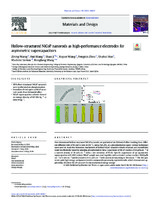| dc.contributor.author | Linkov, Vladimir M. | |
| dc.contributor.author | Wang, Zining | |
| dc.contributor.author | Wang, Hui | |
| dc.date.accessioned | 2021-01-18T07:44:28Z | |
| dc.date.available | 2021-01-18T07:44:28Z | |
| dc.date.issued | 2020 | |
| dc.identifier.citation | Linkov, V. M. et al. (2020). Hollow-structured NiCoP nanorods as high-performance electrodes for asymmetric supercapacitors. Materials and Design ,193,108807. | en_US |
| dc.identifier.issn | 1873-4197 | |
| dc.identifier.uri | 10.1016/j.matdes.2020.108807 | |
| dc.identifier.uri | http://hdl.handle.net/10566/5656 | |
| dc.description.abstract | One-dimensional hollow-structured NiCoP nanorods are synthesized via Kirkendall effect resulting from different diffusion rates of Ni and Co ions at 350 °C, using NaH2PO2 as a phosphorization agent. Various techniques were used to study the formation mechanism of hollow NiCoP nanorods which structure and crystallinity could be effectively tuned by adjusting phosphorization time. Capacitance of NiCoP reaches 273.4 μAh cm−2 at a current density of 30 mA cm−2 with a rate retention of 85.6%. Specific capacitance of an asymmetric supercapacitor cell (ASC) where NiCoP sample was used together with activated carbon reached 264.6 μAh cm−2 at 2 mA cm−2 and decreased to 213.2 μAh cm−2 with current density rising to 30 mA cm−2. The ASC possesses quite high energy- and power densities, compared to previously reported results, which demonstrates applicability of hollow NiCoP nanorods for electrochemical energy storage. | en_US |
| dc.language.iso | en | en_US |
| dc.publisher | Elsevier | en_US |
| dc.subject | Energy storage | en_US |
| dc.subject | Hollow structure | en_US |
| dc.subject | Kirkendall effect | en_US |
| dc.subject | NiCoP | en_US |
| dc.subject | One-dimensional | en_US |
| dc.title | Hollow-structured NiCoP nanorods as high-performance electrodes for asymmetric supercapacitors | en_US |
| dc.type | Article | en_US |

